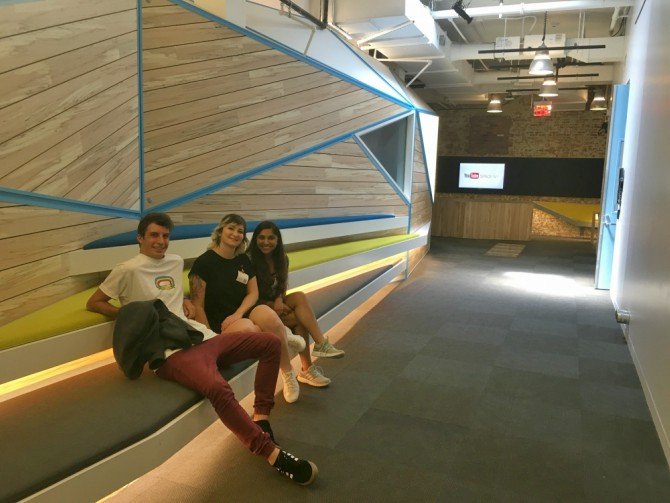On a hot, humid Friday afternoon in New York City, 10 global citizens met at the YouTube headquarters to raise their voices in order to illustrate a vision for the future of education.
 From left to right; Gianmarco Bauer, Carol Harbs, Anisha Kapri
From left to right; Gianmarco Bauer, Carol Harbs, Anisha Kapri
Why is this relevant now?
Currently, the Education Commission is wrapping up final meetings to set the financing agenda for their plan on how to achieve SDG 4. They passed along part of the challenge to us, the global youths around the world, in the format of a video challenge. They understand youth has a place vocalizing and shaping the future landscape of education.
Students are solution builders, so why not let them provide some the solutions?
The Challenge

The Education Youth Video Challenge was set up by the commission with support from A World At School and MTV Voices. The challenge called upon global youths to share their vision for the future of education by responding to the following questions in a 30 second video:
1. How can education best prepare you for your future?
2. What would your ideal school of the future look like?
In mid-July, the esteemed Education Commission Youth Panel, which includes panelists like Malala Yousafzai, will vote on video entries and offering the top winners prizes. The grand prize is a trip to New York in September to watch the film be presented during the United Nations General Assembly.
Answering their call, we sent out an invitation out to all registered global citizens inviting them to come join us at the Youtube HQ in New York to record these videos. We couldn’t have predicted the incredible and inspiring turnout. (Or the cool space that Youtube hosts, free snacks and all!)
With the new Sustainable Development Goals, came the Education Commission -- a coalition launched to help the world develop a plan for achieving SDG 4: Quality Education. This goal calls on the world to “ensure inclusive and equitable quality education and promote lifelong learning opportunities for all.” This is a BIG challenge, so let’s break it down into the facts and two distinct trouble spots affecting education around the world today -- access and quality.
Access
1. More than 124 million children and youth do not have access to primary and secondary school.
2. Of the 590 million children who are in school, some 250 million or about two in five fail to learn basics skills in reading, writing, and math.
3. 781 million illiterate adults and young adults cannot afford to continue their studies.
Quality
1. Getting students access to school is the first challenge, but what they learn matters too!
2. Facilities and resources, like access to internet, bathrooms, and present well-trained teachers can make all the difference for a school’s quality of education.
Here is a glimpse into the powerful voices of global citizens who answered the challenge.

Anisha and Mojúbàolú were two of the 10 global citizens who shared their vision for education, including quality financing, girls’ education, safe schooling, and more.
Anisha, originally from Nepal, founded the Promise of a Cycle initiative in Ghana, making sure children have bikes so that they can access schools safely. Now, she advocates for gender equality in Nepal, fighting period taboos limiting girls access to school.
“I am from Nepal. Because of education, I am financially independent. I have the freedom to decide what job I should do and when to get married. I can study anything I want without being questioned and make my dreams into a reality without being judged. I know my rights. I have learned to speak for myself and for other girls. I can break my barriers and make my own future. I can connect with anyone or anywhere around the world.”
Mojúbàolú, deeply ingrained in education, teaches students in Brooklyn about human rights and politics. When she is not in the classroom, she is helping lead the Bring Back Our Girls campaign in New York to continue to push the Nigerian government to save the Chibok girls from Boko Haram.
“Guaranteed equal and equitable access to excellent education, especially for girls, builds a better world and glorious future. Excellent education should be a right available to every child. It’s an investment in the future. It supports human and national security. I’m from Nigeria, which has the most out of school children in the world (over 10 million). I call on Nigeria’s government to actualize its Education for All commitment, and to rescue our Chibok Girls, abducted from their school by Boko Haram over two years ago. Let’s make all schools safe havens where children can joyfully learn, thrive, and grow.”
Moments like these where we can meet in person, in any city around the world, discuss our dreams and passions for education can act as a reminder of what it truly means to be a global citizen. There is always more power in sharing your voice and vision than you think.

If you would like to watch the final videos from out day at YouTube, check them out here. Voting ends July 15th, so make sure to watch all of the entries here for the competition and vote!